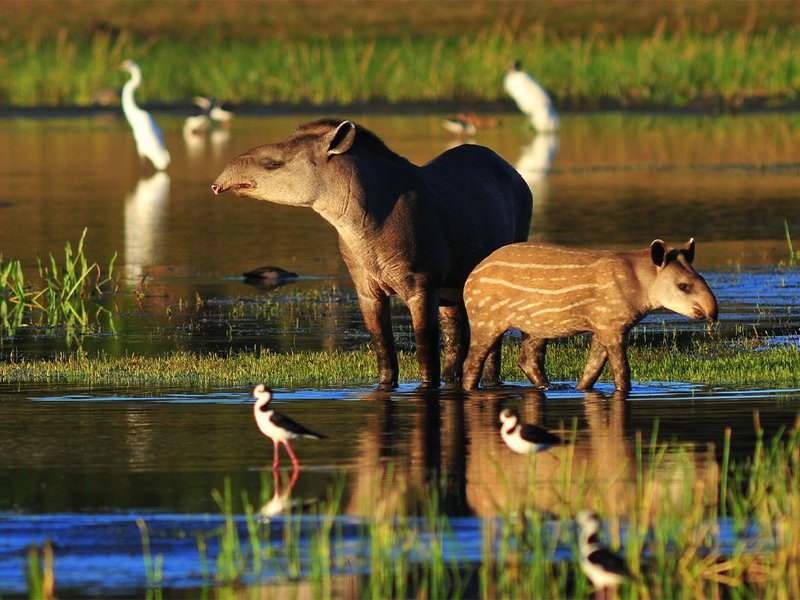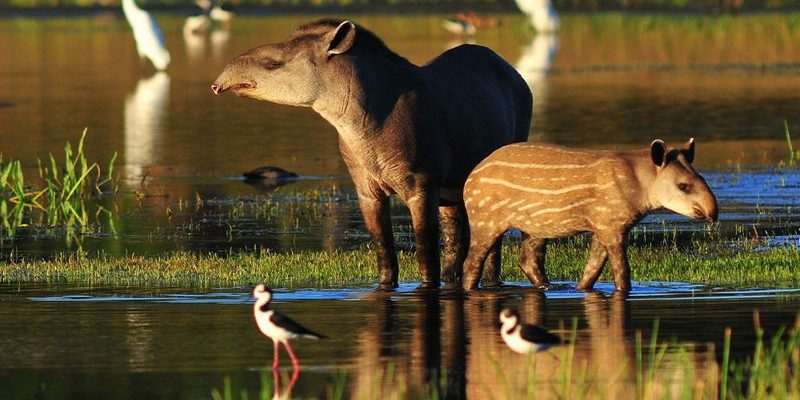
A tapir is one of nature’s most unique creatures, quite unlike any other animal you might’ve encountered. Imagine a hefty animal with a body resembling that of a small hippopotamus, but with a long, flexible snout that looks a bit like an elephant’s trunk. These gentle giants belong to the family Tapiridae and are native to Central and South America, as well as Southeast Asia. Their appearance might be unusual, but trust me, they are utterly captivating!
You might be wondering about their lifestyle. Tapirs are herbivores, spending much of their time munching on leaves, fruits, and aquatic plants. They have a knack for blending into their surroundings, thanks to their dark, bristly fur and somewhat chunky shape. Their ability to hide and roam through dense underbrush makes them hard to spot in the wild, which is both fascinating and a little sad because they face threats from habitat loss and poaching.
In this article, we’ll deep dive into the life of tapirs, exploring their habitat, behavior, diet, and more. By the end, you’ll have a greater appreciation for these incredible animals and understand why they deserve our protection.
General Characteristics of Tapirs
Tapirs are intriguing creatures, and their characteristics are just as unique as their appearance. Adults usually weigh between 400 to 900 pounds, and they can stand around 3 feet tall at the shoulder. They have short legs but a robust body, which gives them remarkable strength and stability when moving through their habitats. Their elongated snouts, or proboscis, are not just for show; these handy tools help them grasp leaves and fruits, making eating a breeze.
Tapirs can be found in a range of colors, from dark brown to greyish tones, which help them camouflage within their forest environments. They also have a distinct, white stripe that runs from their eyes to their jaws, and lighter patches on their ears, making them truly unique. This coloration helps them stay hidden from potential predators, like jaguars and crocodiles.
Another fascinating aspect of tapirs is their lifespan. In the wild, they can live up to 25 to 30 years, but in captivity, with proper care, they can reach ages of up to 40 years. Their relatively long lifespan allows for both behavioral studies and an opportunity to observe how they interact with their environments over time.
Habitat and Distribution
Tapirs primarily inhabit rainforest regions, but they are quite adaptable and can also be found in grasslands, swamps, and even mountainous areas. The four species of tapirs include the Brazilian tapir, Baird’s tapir, Malayan tapir, and the mountain tapir, each having its own specific habitat preferences. For instance, the Brazilian tapir is often found near rivers and swamps in the Amazon Basin, while the Malayan tapir prefers the dense forests of Southeast Asia.
Their habitats play a vital role in their survival. Tapirs require access to water for drinking and bathing, as they LOVE to stay cool! They are often seen wallowing in mud – it not only helps keep them cool but also protects their skin from sunburn and insects. If you ever visit a zoo, keep an eye out for these delightful creatures splashing around!
Unfortunately, deforestation is a significant threat to tapir populations. As humans expand into their natural landscapes, tapirs find it harder to thrive. Conservation efforts are essential for protecting their habitats and ensuring these gentle giants continue to roam the earth for many years to come.
Diet and Feeding Habits
Diet-wise, tapirs are mostly browsing herbivores, which means they dine on a variety of leaves, fruits, and grasses. Their strong, flat molars are perfect for grinding tough plant materials. Tapirs are particularly fond of fruits, which are a great source of water and energy. In the lush forests where they reside, they act as important seed dispersers, helping to regenerate plant life by eating and excreting seeds in different locations.
You might be surprised to learn that tapirs can consume up to 100 pounds of food each day! They are typically crepuscular, meaning they’re most active during dawn and dusk. This unique feeding schedule minimizes competition with other animals and helps them avoid predators. Plus, their foraging habits play a vital role in maintaining their forest ecosystem.
What’s truly fascinating is how these creatures use their sense of smell to find food. Their snouts are highly sensitive, allowing them to locate fruits and leaves with ease. Just like you might follow your nose to a delicious meal, tapirs can do the same in their environments. If you’re ever lucky enough to see one of these animals in action, you might be entranced by how gracefully they navigate their surroundings while on the hunt for their next snack!
Behavior and Social Structure
Tapirs are generally solitary animals, but their behavior can vary based on the species and environmental factors. They are known to be quite shy, often retreating into dense vegetation when approached. Despite being solitary, male and female tapirs come together for mating, with the females giving birth to a single calf after a gestation period of about 13 months. Those calf moments are especially precious, as the young tapirs have a unique striped and spotted coat that helps them blend in with forest shadows.
You may find it interesting that tapirs are quite nocturnal, which means they’re more active at night. Their nighttime wanderings are perfect for avoiding predators and seeking food without being easily spotted. Their keen senses of smell and hearing enable them to stay alert in the dark, making them effective foragers and survivors.
They communicate using a variety of sounds, including whistles, grunts, and growls. This vocalization is crucial for mother-calf interactions, especially in the formative months when the calf is learning to explore its environment. Just like humans might raise their voices to call a loved one, tapirs use their sounds to connect and establish their presence.
Conservation Status
Sadly, tapirs are facing severe threats to their survival. According to the International Union for Conservation of Nature (IUCN), two of the four species are listed as endangered, while the others are classified as vulnerable. The primary reason for their declining numbers is habitat loss, primarily due to deforestation and agricultural expansion. As forests are cleared and fragmented, tapirs lose their homes and access to food sources, leading to dwindling populations.
In addition to habitat loss, tapirs are often hunted for their meat and skin in some parts of the world. Conservation groups are working tirelessly to promote tapir protection through education and habitat preservation. By raising awareness, we can help support these efforts and advocate for policies that protect their habitats.
Fortunately, there are several protected areas and wildlife reserves dedicated to safeguarding tapirs and their habitats. Initiatives to educate local communities about the importance of tapirs in ecosystems are also underway. Everyone can play a role in conservation, whether it’s supporting local conservation organizations or simply spreading the word about the importance of saving these fascinating animals.
Interesting Facts about Tapirs
| Species | Brazilian Tapir | Baird’s Tapir | Malayan Tapir | Mountain Tapir |
| Weight | 400-800 lbs | 550-750 lbs | 600-900 lbs | 400-600 lbs |
| Length | 6-8 feet | 6-8 feet | 7-8 feet | 5-6 feet |
| Lifespan | 25-30 years in the wild | 25-30 years in the wild | 30-35 years in captivity | 20-30 years in the wild |
| Habitat | Amazons and swamps | Rainforests in Central America | Forests of Southeast Asia | Andes mountains |
How to Help Tapirs
If you’re passionate about making a difference for tapirs, there are several ways you can contribute. One impactful way is to support conservation organizations focused on protecting their habitats and educating local communities. These organizations often run programs that restore degraded lands and create protected areas where tapirs can thrive.
Another way you can help is by reducing your own ecological footprint. This could mean making sustainable choices, such as choosing products that are certified sustainable, reducing plastic use, or supporting local wildlife-friendly businesses. By advocating for responsible consumer habits, we can collectively contribute to the welfare of tapirs and their ecosystems.
Lastly, spreading the word is crucial! Share information about tapirs with your friends and family. Whether it’s on social media or during a coffee chat, raising awareness can lead to greater support for conservation efforts. Together, we can help secure a future where tapirs continue to be part of our world.
FAQ
What do tapirs eat?
Tapirs are herbivores, primarily dining on leaves, fruits, and grasses. They have adapted to eating a wide variety of plant materials, aiding their role as important seed dispersers in their ecosystems.
How many species of tapir are there?
There are four recognized species of tapir: the Brazilian tapir, Baird’s tapir, Malayan tapir, and mountain tapir. Each has its own unique characteristics and habitat preferences.
Are tapirs dangerous to humans?
Generally, tapirs are not considered dangerous to humans. They are shy animals and will typically avoid contact. However, like any wild animal, they may react defensively if they feel threatened.
Can tapirs swim?
Yes, tapirs are excellent swimmers! They often take to water to cool off or escape threats. Their bodies are designed for buoyancy, allowing them to swim quite effectively.
How long do tapirs live?
In the wild, tapirs can live around 25 to 30 years, while in captivity, they may live up to 40 years with proper care. Their lifespan can vary depending on environmental factors and threats.
What threats do tapirs face?
Tapirs face significant threats, primarily from habitat loss due to deforestation and hunting. These factors have led to declining populations, making conservation efforts critical for their survival.
How can I support tapir conservation?
You can support tapir conservation by donating to organizations focused on habitat preservation, spreading awareness about their plight, and making sustainable lifestyle choices that minimize environmental impact.
Are tapirs related to any other animals?
Tapirs are part of the order Perissodactyla, which also includes horses and rhinoceroses. While they may look quite different, they share a common ancestor that lived millions of years ago.
Do tapirs have any natural predators?
Yes, tapirs do have natural predators. In the wild, their main threats include big cats like jaguars and pumas, as well as crocodiles in areas where they inhabit water. Their camouflage helps them avoid detection, but they remain vulnerable.
How do tapirs communicate with each other?
Tapirs communicate through various vocalizations, including whistles, grunts, and growls. These sounds play an important role in mother-calf bonding and establishing presence within their territories.
What is the role of tapirs in the ecosystem?
Tapirs play a critical role as seed dispersers in their ecosystems. By consuming fruits and excreting seeds in different locations, they help promote biodiversity and contribute to the regeneration of their forest habitats.
Where can I see tapirs in the wild?
To see tapirs in the wild, you’ll need to visit their natural habitats, such as the rainforests of Central and South America or the jungles of Southeast Asia. Guided tours in these regions often provide opportunities to spot these elusive animals.
What is a baby tapir called?
A baby tapir is often referred to as a calf. When they are born, they have a unique coat featuring stripes and spots, which helps them blend into their surroundings and provides camouflage against potential predators during their early days.

